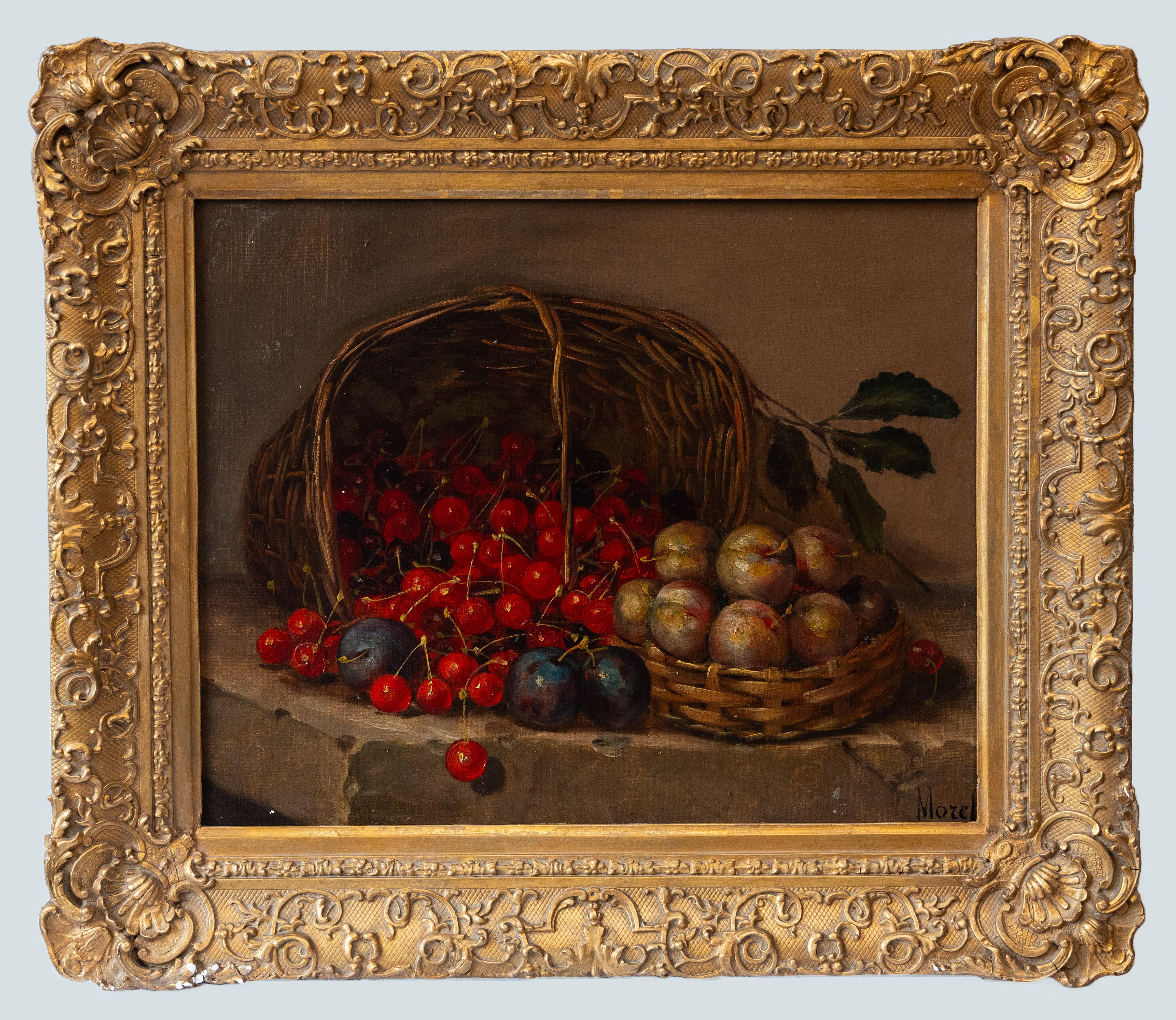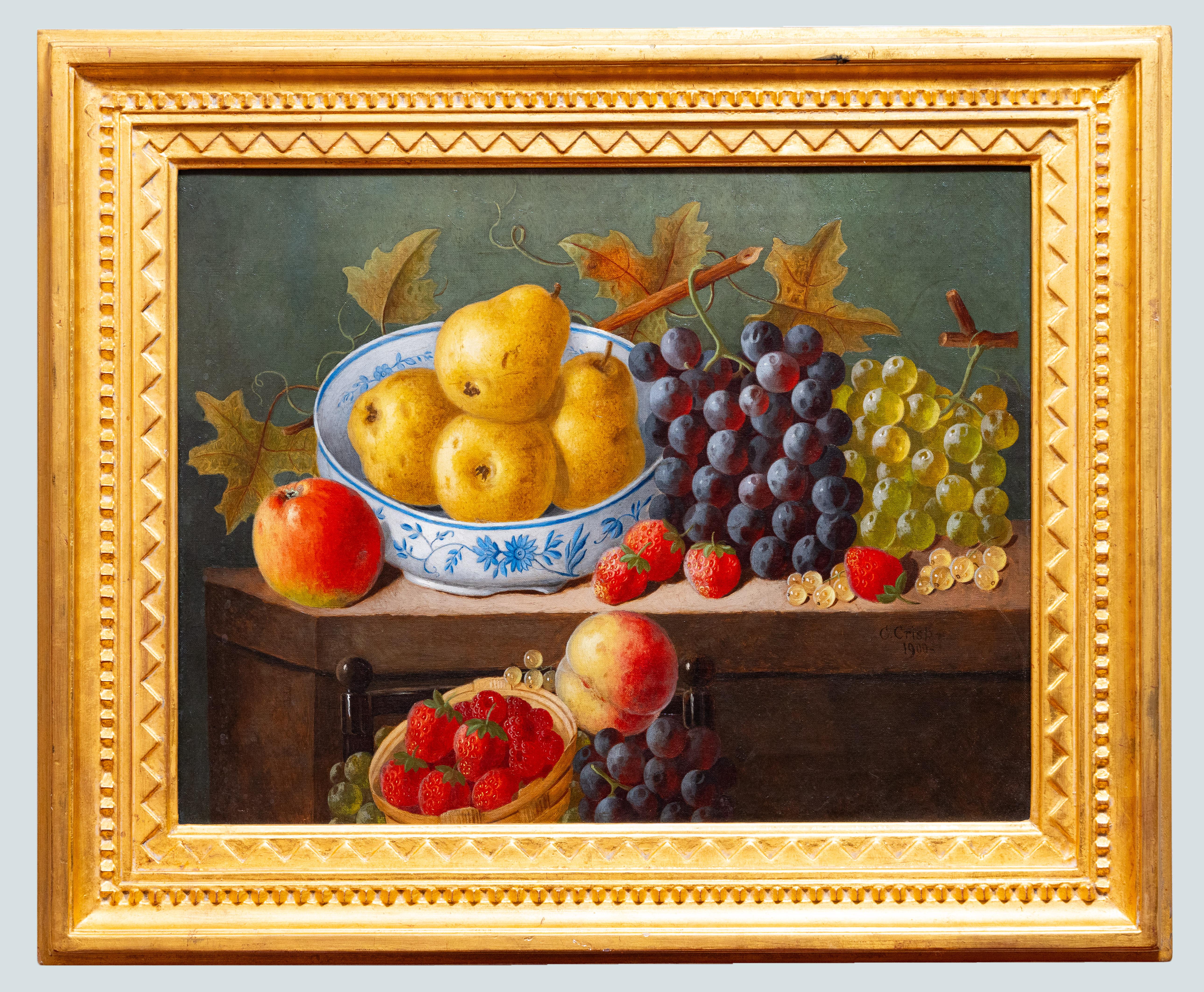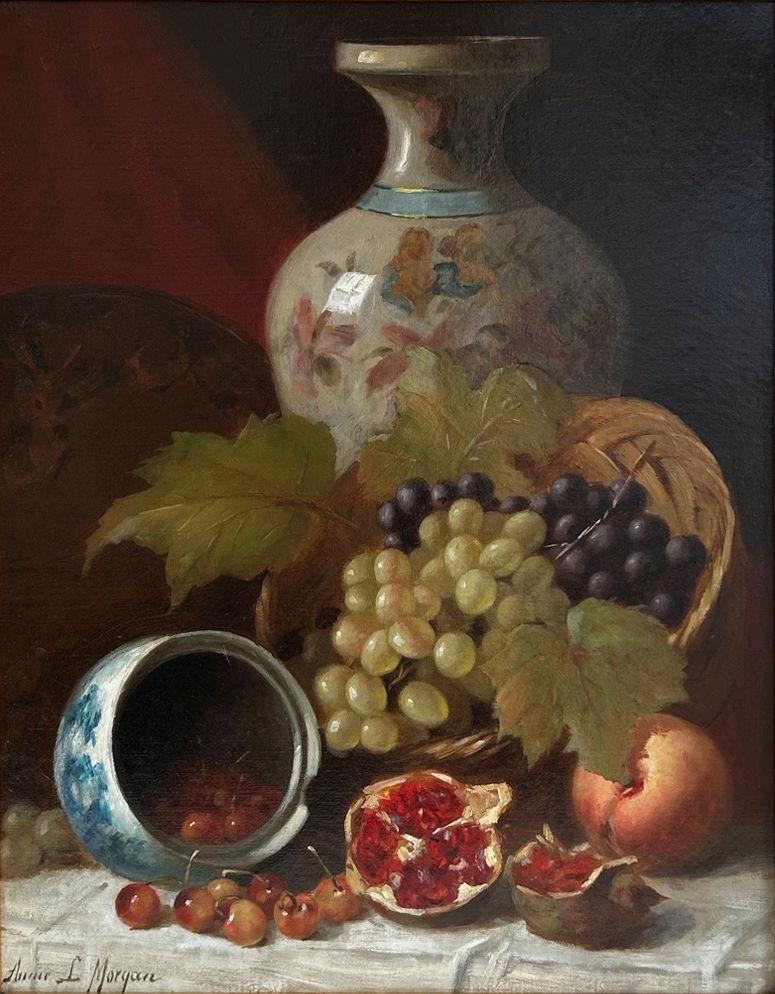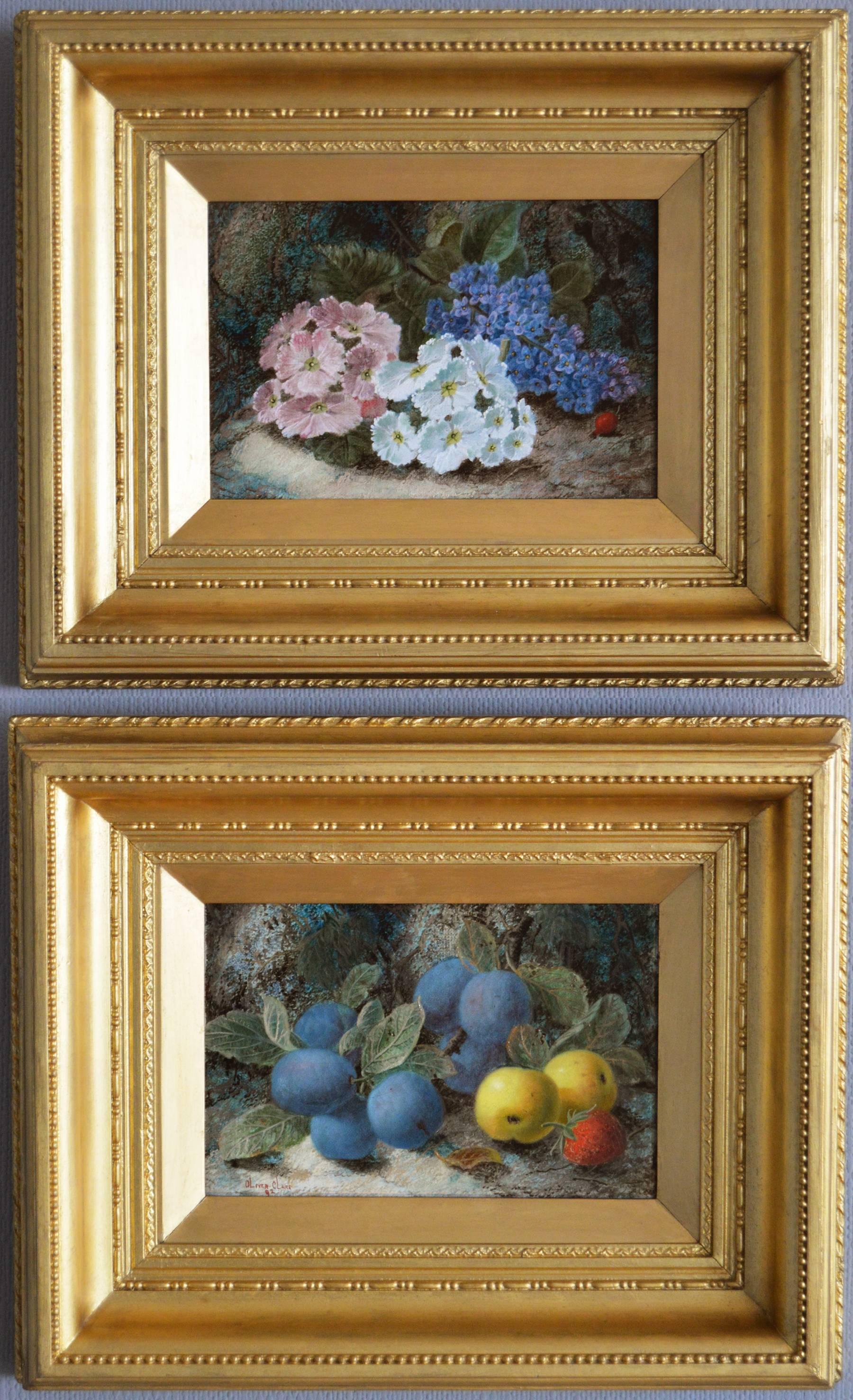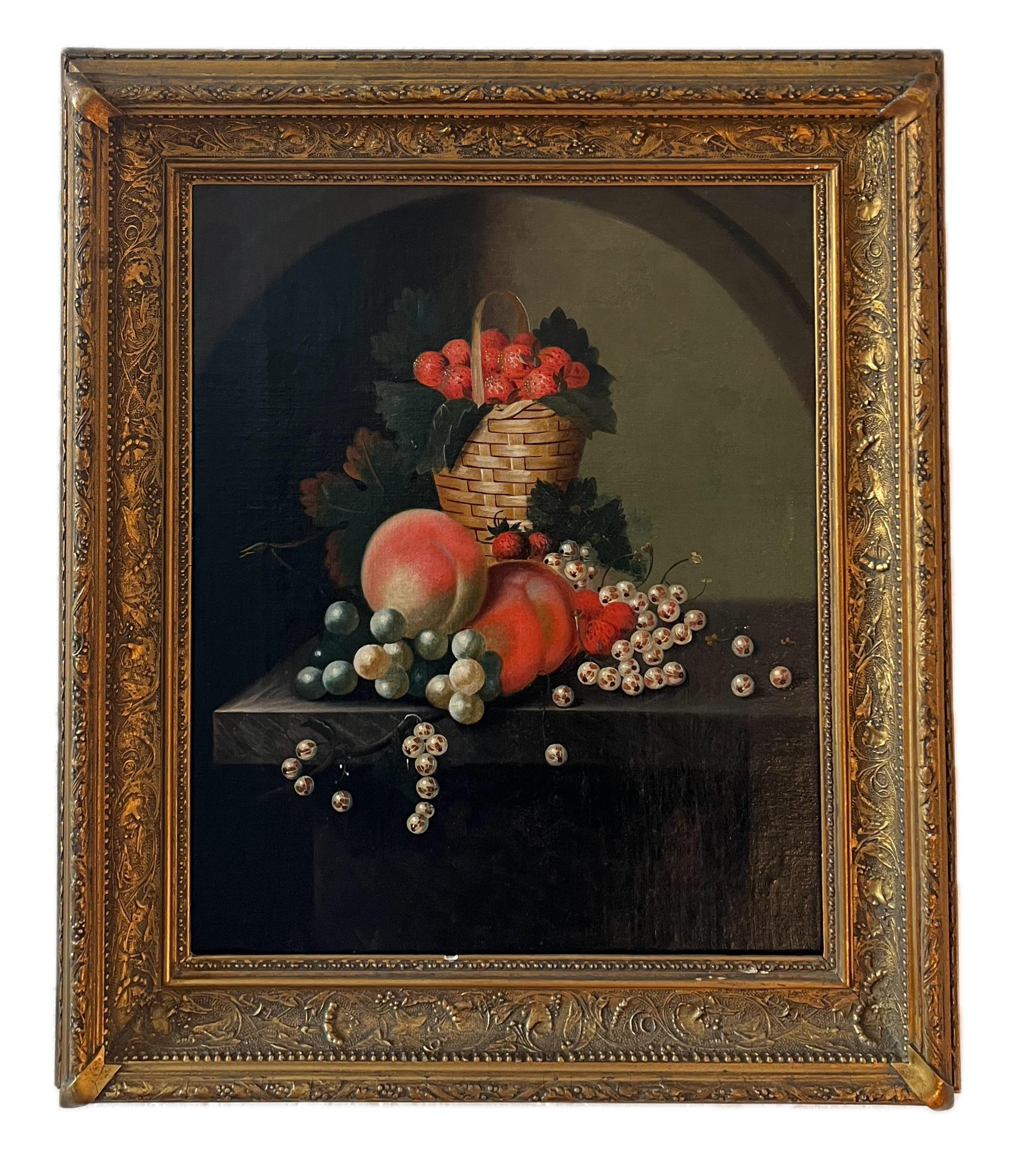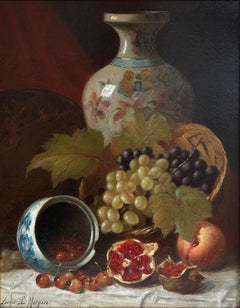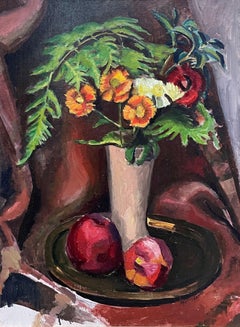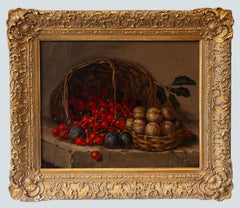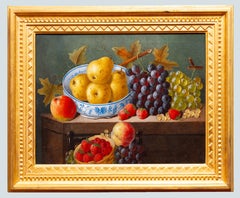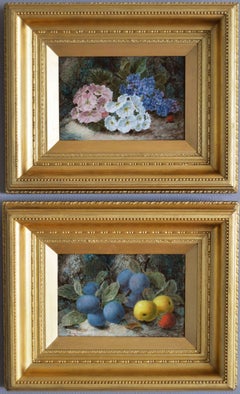Items Similar to Pair of Fruit Still Lifes, Sarah Miriam Peale, Cherries and Raspberries Basket
Want more images or videos?
Request additional images or videos from the seller
1 of 11
Sarah Miriam PealePair of Fruit Still Lifes, Sarah Miriam Peale, Cherries and Raspberries Basketcirca 1860
circa 1860
$48,000
£36,115.54
€41,714.21
CA$67,836.53
A$73,612.98
CHF 39,008.39
MX$902,827.30
NOK 482,726.02
SEK 456,150.53
DKK 311,417.42
About the Item
A pair of still lifes:
Sarah Miriam Peale
Cherries, circa 1860
Oil on canvas
12 x 10 inches
Provenance:
Kennedy Galleries, New York
Private Collection (acquired from the above in 1966)
Exhibited:
Baltimore, Maryland, Peale Museum, Miss Sarah Miriam Peale: 1800-1885, Portraits and Still Life, 1967, no. 42, p. 17, illustrated.
Philadelphia, Philadelphia Museum of Art, The Peale Family: Creation of an American Legacy, 1770-1870, 1996-97, pl. 61, p. 97, illustrated; this exhibition later traveled to Washington, D.C., National Portrait Gallery; Washington, D.C., Corcoran Gallery of Art; San Francisco, M.H. de Young Memorial Memorial Museum.
Sarah Miriam Peale
Basket with Berries, circa 1860
Oil on canvas
12 x 10 inches
Provenance:
Kennedy Galleries, New York
Private Collection (acquired from the above in 1966)
Exhibited:
Baltimore, Maryland, Miss Sarah Miriam Peale: 1800-1885, Portraits and Still Life, 1967, no. 43, p. 34, illustrated.
Philadelphia, Philadelphia Museum of Art, The Peale Family: Creation of an American Legacy, 1770-1870, 1996-97, pl. 125, pp. 245-46, illustrated; this exhibition later traveled to Washington, D.C., National Portrait Gallery; Washington, D.C., Corcoran Gallery of Art; San Francisco, M.H. de Young Memorial Memorial Museum.
One of the many artist descendants of Charles Willson Peale, Sarah Peale was born in Philadelphia and became America's first professional female artist and a leading portrait painter of her day. She also did still lifes. Her art career lasted nearly sixty years, and she supported herself financially and successfully competed with male painters of that time including John Wesley Jarvis, Thomas Sully, and Jacob Eichholtz.
Her father was James Peale, a brother of Charles Willson, and her family called her Sally. She took early art training from her uncle, Charles Willson Peale, in his studio in Washington D.C., and he, unlike her father, was a believer in the equality of women and encouraged her to pursue her talent.
He led her to many good contacts by taking her to numerous social events in Washington D.C., where she charmed many people in society, which, in turn, secured her important commissions. She was also a close friend of Thomas Sully, another prominent portrait painter, and he took Sarah and his own daughters to lectures on anatomy, a subject closed to women of that era because of the indelicacy of the subject.
Her first large painting, a self portrait, was completed in 1818. From 1816 to 1831, she worked between Philadelphia and Baltimore, and then in 1825 moved to Baltimore where she worked in the Peale Museum run by her cousin Rembrandt. She became the most sought after portraitist of Baltimore, painting more than one-hundred of its leading citizens in a style that was regarded as skillfully realistic. Her subjects looked dignified, pleasant, and capable and had expressions that conveyed the idea they were genuinely human. Her early work had more decorative touches than her later pieces.
Although most commissions were from people who sought her, she also solicited commissions such as that of the Marquis de Lafayette, the French Ambassador, whom she contacted to pose for her when he came to Washington. He agreed and sat four times, but unfortunately the work is lost. Other politician subjects include Senator Thomas Hart Benton, Caleb Cushing and Daniel Webster.
In 1824, Sarah Peale became the first woman elected an Academician of the New York National Academy, which was in those days was the stamp of an artist's authenticity of meeting certain prescribed standards. Her sister, Anna Claypoole Peale, was also among the first female Academy members.
In 1845, because of ill health, she moved to St. Louis, Missouri at the invitation of its United States Senator, Trusten Polk. She liked the city and stayed for 32 years, becoming that city's leading portrait painter. Towards the end of her life, she took an increasing interest in still-life painting and won many prizes at the St. Louis fairs and other exhibitions. Reflecting the changing, loosening of styles, her still lifes, often with fruit, are much more freely painted than her early work. In 1878, she returned to Philadelphia, where she, never married, lived until her death in 1885 with two older widowed sisters.
About the Seller
5.0
Platinum Seller
Premium sellers with a 4.7+ rating and 24-hour response times
Established in 2022
1stDibs seller since 2022
122 sales on 1stDibs
Typical response time: <1 hour
- ShippingRetrieving quote...Shipping from: New York, NY
- Return Policy
Authenticity Guarantee
In the unlikely event there’s an issue with an item’s authenticity, contact us within 1 year for a full refund. DetailsMoney-Back Guarantee
If your item is not as described, is damaged in transit, or does not arrive, contact us within 7 days for a full refund. Details24-Hour Cancellation
You have a 24-hour grace period in which to reconsider your purchase, with no questions asked.Vetted Professional Sellers
Our world-class sellers must adhere to strict standards for service and quality, maintaining the integrity of our listings.Price-Match Guarantee
If you find that a seller listed the same item for a lower price elsewhere, we’ll match it.Trusted Global Delivery
Our best-in-class carrier network provides specialized shipping options worldwide, including custom delivery.More From This Seller
View All"Still Life with Cherries, Grapes" Annie L. Morgan, Academic Fruit Still Life
Located in New York, NY
Annie L. Morgan
Still Life with Cherries, Grapes, and Pomegranate, circa 1880
Signed lower left
Oil on canvas
20 x 16 inches
Category
1880s Academic Figurative Paintings
Materials
Canvas, Oil
"Still Life of Fruit " Albert Swinden, American Abstract Association, AAA
By Albert Swinden
Located in New York, NY
Albert Swinden (1901 - 1961)
Still Life of Fruit, 1937
Oil on canvas
18 x 30 inches
Provenance:
Graham Gallery, New York
Albert Swinden (1901–1961) was an English-born American abstract painter. He was one of the founders of the American Abstract Artists, and he created significant murals as part of the Federal Art Project.
Albert Swinden was born in Birmingham, England in 1901. When he was seven, he moved with his family to Canada, and in 1919 he immigrated to the United States. He lived in Chicago, where he studied for about a year and a half at the Art Institute. He then relocated to New York City, where his art education continued briefly at the National Academy of Design. He soon changed schools again, to the Art Students League, which he attended from 1930 to 1934. He studied with Hans Hofmann and gained an appreciation for Synthetic Cubism and Neoplasticism. According to painter and printmaker George McNeil, Swinden "could have influenced Hofmann ... He was working with very, very simple planes, not in this sort of Cubistic manner. Swinden was working synthetically at this time." While still a student, Swinden began teaching at the Art Students League, in 1932.
Swinden married Rebecca Palter (1912–1998), from New York. Their daughter, Alice Swinden Carter, also became an artist. Carter, who attended the School of the Museum of Fine Arts, Boston, received an award from the Institute of Contemporary Art, Boston for her large sculptures.
Swinden was hired for the Federal Art Project (FAP) of the Works Progress Administration (WPA), and he is best known for the murals which he painted as part of that project.
In 1935, New York City Mayor Fiorello La Guardia attended the opening of the inaugural exhibit at the Federal Art Project Gallery, accompanied by Audrey McMahon, New York regional director for the Works Progress Administration/Federal Art Project. Among the works on display was Abstraction, a sketch by Swinden; it was the design for a mural planned for the College of the City of New York. A newspaper account described it as consisting of "brightly colored T-squares, triangles and rulers in horizontal, vertical and diagonal positions". La Guardia asked what it was, and upon being told it was a mural design, he said he didn't know what it depicted. Someone joked that it could be a map of Manhattan. The displeased mayor stated that "if that's art, I belong to Tammany Hall." (Tammany Hall, which the Republican mayor referenced, was the New York Democratic Party political society.) Fearing that the mayor's negative attitude could jeopardize the future of abstract art within the Federal Art Project, McMahon dispatched an assistant to summon an artist who could speak to the mayor in defense of abstraction. The assistant returned with Arshile Gorky.
Swinden played an important role in the founding of the American Abstract Artists. In 1935, he met with three friends, Rosalind Bengelsdorf, her future husband Byron Browne, and Ibram Lassaw, with the goal of exhibiting together. The group grew and started meeting in Swinden's studio, which adjoined those of Balcomb and Gertrude Greene...
Category
1930s Modern Still-life Paintings
Materials
Canvas, Oil
$4,800 Sale Price
20% Off
"Fruit" Georgina Klitgaard, Apples and Pears Still Life, Woodstock Female Artist
By Georgina Klitgaard
Located in New York, NY
Georgina Klitgaard
Apples and Pears Still Life
Signed lower right
Oil on canvas
8 x 10 inches
Georgina Klitgaard’s art has sometimes gotten lost in the critical propensity to assign artists to membership in one school or another. Unfortunately for her posthumous reputation, Klitgaard defied easy characterization. She was a U.S. modernist, working in both oil and watercolors, but never abandoned figurative painting. She made her reputation in landscape but also excelled in portraits, flower studies, and even cityscapes. Yet despite Klitgaard’s ambiguous status in art history, her paintings continue to fascinate viewers attracted to the unsteady ground between twentieth-century realism and expressionism.
Georgina Klitgaard (née Berrian) was born in Spuyten Duyvil, New York (now part of the Bronx); the Berrians had lived in the area since at least the U.S. Revolution. After graduating from Barnard College, she studied art at the National Academy of Design. In 1919 she married Kay Klitgaard, a Danish artist and writer. The next year, her life took a decisive turn when the couple visited friends in Woodstock, NY—about 120 miles north of New York City--and fell in love with the area.
In 1906, L. Birge Harrison helped found the Art Students League Summer School in Woodstock and the area became a magnet for landscape painters. The Klitgaards bought a house in 1922 on a steep ledge at the end of Cricket Ridge, high above Bearsville, which provided panoramic vistas overlooking the Catskill Mountains and the Hudson Valley. Klitgaard joined the artists’ colony in the area, which at the time included artists Ernest Fiene and Katherine Schmidt.
Klitgaard exhibited widely and her career slowly developed momentum. She was a regular contributor at Whitney Museum shows from 1927 to 1944. In 1929, she exhibited a painting entitled “Carousel” in the Whitney Studio Club’s famous exhibition “Circus in Paint.” Gertrude Vanderbilt Whitney acquired five paintings by Klitgaard in the early 1930s and served as a significant patron for the artist. Klitgaard s New York dealer, Frank Rehn...
Category
Early 20th Century Modern Still-life Paintings
Materials
Canvas, Oil
"Floral Still Life with Two Apples" Hayley Lever, Modernist Still Life Painting
By Hayley Lever
Located in New York, NY
Hayley Lever
Floral Still Life with Two Apples
Signed lower right
Oil on canvas
20 x 16 inches
Hayley Lever’s versatility has worked against his posthumous reputation. He was never...
Category
Early 20th Century Modern Still-life Paintings
Materials
Canvas, Oil
"Untitled" Albert Heckman, circa 1950 Modernist Colorful Still Life With Fruit
By Albert Heckman
Located in New York, NY
Albert Heckman
Untitled, circa 1950
Signed lower right
Oil on canvas
24 x 30 inches
Albert Heckman was born in Meadville, Western Pennsylvania, 1893. He went to New York City to try his hand at the art world in 1915 after graduating from high school and landing a job at the Meadville Post Office. In 1917, at the age of 24, Heckman enrolled part-time in Teachers' College, Columbia University's Fine Arts Department to begin his formal art education. He worked as a freelance ceramic and textile designer and occasionally as a lecturer at the Metropolitan Museum of Art. In the early 1920s, at the age of almost 30, he graduated with a Bachelor of Arts degree from Columbia Teachers College. He was especially impacted by his instructor at Columbia, Arthur Wesley Dow.
After graduating, he was hired by the Teachers' College as a Fine Arts instructor. He stayed with Columbia Teachers' College until 1929, when he left to attend the Leipzig Institute of Graphic Arts in Leipzig, Germany. Isami Doi (1903-1965), who was born in Hawaii, was arguably his most impressive student at Columbia. Doi is now regarded as one of the most prominent artists hailing from Hawaii. Heckman became an active member and officer of the Keramic Society and Design Guild of New York in the 1920s as part of his early commercial art career. The Society's mission was to share knowledge and showcase textile and ceramic design exhibits.
In 1922, Heckman married Florence Hardman, a concert violinist. Mrs. Heckman's concert schedule during the 1920s kept Albert and Florence Heckman apart for a significant portion of the time, but they spent what little time they had together designing and building their Woodstock, New York, summer house and grounds. A small house and an acre of surrounding land on Overlook Mountain, just behind the village of Woodstock, were purchased by Albert and Florence Heckman at the time of their marriage. Their Woodstock home, with its connections, friendships, and memories, became a central part of their lives over the years, even though they had an apartment in New York City.
Heckman's main artistic focus shifted to the house on Overlook Mountain and the nearby towns and villages, Kingston, Eddyville, and Glasco. After returning from the Leipzig Institute of Graphic Arts in 1930, Mr. Heckman joined Hunter College as an assistant professor of art. He worked there for almost thirty years, retiring in 1956. Throughout his tenure at Hunter, Mr. Heckman and his spouse spent the summers at their Woodstock residence and the winters in New York City. They were regular and well-known guests at the opera and art galleries in New York. Following his retirement in 1956, the Heckmans settled in Woodstock permanently, with occasional trips to Florida or Europe during the fall and winter. Mr. Heckman's close friends and artistic career were always connected to Woodstock or New York City. He joined the Woodstock art group early on and was greatly influenced by artists like Paul and Caroline Rohland, Emil Ganso, Yasuo Kuniyoshi, Andre Ruellan, and her husband, Jack...
Category
1950s Modern Interior Paintings
Materials
Canvas, Oil
"Still Life with Pink Ewer and Sheet Music" Nicholas Alden Brooks, Trompe L'oeil
By Nicholas Alden Brooks
Located in New York, NY
Nicholas Alden Brooks
Still Life with Pink Ewer and Sheet Music, 1891
Signed and dated lower right
Oil on canvas
20 1/8 x 16 inches
Considerable mystery surrounds the name Nicholas Alden Brooks. Other than having been active in New York City between 1880 and 1904, very little is known about the artist. There are no records of any art societies showing him as a member or his having participated in any exhibits. The name Brooks, in fact, could possibly be a pseudonym for Robert Fullington, whose name appears on theatrical memorabilia in Brookss trompe loeil still-life paintings.
William Harnett...
Category
1890s Realist Still-life Paintings
Materials
Canvas, Oil
You May Also Like
Still Life with Cherries and Plums, French School 20th century
Located in GB
This refined still life painting, signed Morel, belongs to the 20th-century French School and depicts a basket brimming with cherries, alongside black and green plums, arranged with ...
Category
20th Century Still-life Paintings
Materials
Oil, Board
Still life with fruits, pears strawberries, grapes and peaches, 20th century
Located in GB
George Crisp (1875–1916) was a British still-life painter renowned for his meticulous depictions of fruit, flowers, and natural subjects. Active primarily...
Category
Early 20th Century Still-life Paintings
Materials
Canvas, Oil
Antique Painting Plethora of Ripe Raspberries in Fruit Basket signed Bohner
Located in Buffalo, NY
Original frame to the painting. Dramatic highlights and shadows.
Category
Late 19th Century Realist Still-life Paintings
Materials
Oil
19th Century pair of still life oil paintings of fruit and flowers
By Oliver Clare
Located in Nr Broadway, Worcestershire
***PLEASE NOTE: EACH PAINTING INCLUDING THE FRAME MEASURES 13 INCHES X 16 INCHES***
Oliver Clare
British, (1853-1927)
Still Life of Fruit & Still Life of Flowers
Oil on canvas, pair, both signed & dated ‘92
Image size: 6 inches x 9 inches (each)
Size including frame: 13 inches x 16 inches (each)
An appealing pair of still life paintings by Oliver Clare. The first painting shows primroses and lilac blossom next to a red berry. In the second, damsons can be seen next to apples and a strawberry.
Oliver Clare was born in Birmingham in 1853, the son of the flower artist George Clare (1839-1890) and his wife Elizabeth Bowen. His brother Vincent Clare (1856-1917) also became an artist and both would have received tuition from their father who influenced their style and subject matter. At the age of 18 he enlisted as a soldier in the Kings Own regiment, but gave this up to become a full time artist. Like his father, Clare specialised in still life paintings, containing fruit and garden flowers, often on mossy banks.
Sometime after 1871, he moved to London where he married Emma Mary Webb...
Category
19th Century Victorian Still-life Paintings
Materials
Canvas, Oil
Rare 18th Century English Still Life of Grapes, Peaches and Strawberries
Located in Harkstead, GB
A rare and most attractive still life by William Jones of Bath. The sumptuous textures of the peaches, grapes and strawberries contrasting with the dark background. A really handsome...
Category
18th Century Old Masters Still-life Paintings
Materials
Oil, Canvas
Oil Painting Pair by Charles Archer "Still life of Fruit"
By Charles Archer
Located in Mere, GB
Oil Painting Pair by Charles Archer "Still life of Fruit" A Derby painter of still life who exhibited in London and the Royal Birmingham Society of artists. Oil on canvas. One signed...
Category
19th Century Still-life Paintings
Materials
Oil
More Ways To Browse
Antique Invitations
Sarah Brown
Pair Of Still Life Fruit
Pair Paintings Still Life
Paintings Of Cherries
Fruit Basket Painting
Oil Painting Of Cherries
Raspberry Painting
Still Life Raspberries
Marquis De Lafayette
Oil Painting White Flowers In Green Vase
Still Life Kitchen Art
Food Still Life Painting
John Grant
Still Life Orchid
Oil Painting Shell
Victorian Flower Painting
Dahlia Painting
